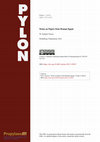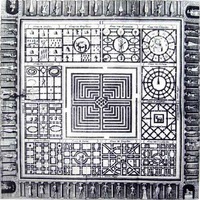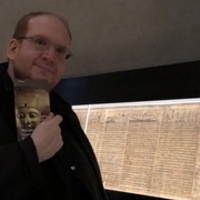Articles by W. Graham Claytor
GRBS, 2024
Edition of a papyrus of 141/2, probably from Soknopaiou Nesos, which tracks the activities of an ... more Edition of a papyrus of 141/2, probably from Soknopaiou Nesos, which tracks the activities of an enslaved woman named Ptolema.
IWNW, 2024
Discussion of the beer industry in the Fayum village of Euhemeria with an edition of P.Fay. 215 d... more Discussion of the beer industry in the Fayum village of Euhemeria with an edition of P.Fay. 215 descr. and a correction to BGU XI 2032.
Journal of Juristic Papyrology, 2023
Edition of P.Mich. inv. 5165a, a petition from an apotactic monk, with discussion of its archaeol... more Edition of P.Mich. inv. 5165a, a petition from an apotactic monk, with discussion of its archaeological context and the evidence from Christianity at Karanis.
Slavery and Dependence in Ancient Egypt. Sources in Translation, 2024
[if not available institutionally, email me for full chapter]
Pylon, 2023
Edition of a will from the University of Michigan collection that includes a rare clause perhaps ... more Edition of a will from the University of Michigan collection that includes a rare clause perhaps influenced by Roman testamentary practice.
Pylon, 2023
Edition of two papyri from Heidelberg mentioning curatores, one a military official involved with... more Edition of two papyri from Heidelberg mentioning curatores, one a military official involved with soldiers' pay, the other likely operating in the civil realm.
TM Archives, 2023
TM Arch 702: www.trismegistos.org/archive/702
TM Archives, 2022
TM Arch 685: www.trismegistos.org/archive/685
TM Archives, 2022
TM Arch 569: www.trismegistos.org/archive/569
TM Archives, 2021
TM Arch 671: www.trismegistos.org/archive/671
TM Archives, 2021
TM Arch 667: www.trismegistos.org/archive/667
TM Archives, 2021
TM Arch 666: www.trismegistos.org/archive/666
TM Archives, 2021
TM Arch 664: www.trismegistos.org/archive/664
TM Archives, 2021
TM Arch 663: www.trismegistos.org/archive/663
Journal of Juristic Papyrology, 2022
Account belonging to the archive of Pakysis (TM Arch 165) written on the back of the Demotic temp... more Account belonging to the archive of Pakysis (TM Arch 165) written on the back of the Demotic temple inventory P 6848. Appendix discusses the acquisition history of the papyrus, which was part of a group of 13 Berlin papyri acquired by the National Museum in Warsaw in 1998.
In: Lajos Berkes – W. Graham Claytor – Maria Nowak, Papyrologische und althistorische Studien zum 65. Geburtstag von Andrea Jördens (Philippika 167), Wiesbaden, Harrassowitz, 307-327, 2023
New evidence on communication practices and salaried work in the administration of Roman Egypt, i... more New evidence on communication practices and salaried work in the administration of Roman Egypt, including two receipts for the salary of official letter carriers (ἐπιστολαφόροι) and one for the salary of a beneficiarius.
Chronique d'Égypte, 2022
(full article embargoed by publisher; email for offprint) Edition of P.Mich. inv. 4188 (Theadelph... more (full article embargoed by publisher; email for offprint) Edition of P.Mich. inv. 4188 (Theadelphia, 62 [?] BCE), a Greek receipt for the "didrachmia of Souchos" with a Demotic subscription. The article includes a full discussion of this 10% property transfer tax due to the temple of Sobek in Arsinoe and attested for properties located throughout the Fayum.

Pylon, 2022
§1 Recently published in P.Messeri is a small fragment from the Musées royaux d'Art et d'Histoi... more §1 Recently published in P.Messeri is a small fragment from the Musées royaux d'Art et d'Histoire de Bruxelles containing the very end of one column and the beginning of the next column of a list of names, most of which have Jewish associations ( P.Messeri 32, I-early II; Tav. XXVII). In column 2, line 9, the editor reads σο κ , expanded as the heading Σοκ(νοπαίου Νῆσος), which is followed by the name Ἰακούβιο[ς …] (the last two letters are difficult to confirm on the plate). While such an abbreviation of the village name finds parallels (e.g. BGU 3 762.1), the sigma in this case sits awkwardly apart from the following letters, and the presence of line ends suggests that the letter instead belongs to the previous column: ο κ is then left as the common abbreviation ὁ κ(αί), indicating that Iakoubios was a second name (his first is presumably lost at the end of the previous line). With this new reading, the document loses its association with Soknopaiou Nesos and the Arsinoite nome (though not its onomastic and cultural interest).










Uploads
Articles by W. Graham Claytor
The village of Karanis in the Fayum is one of the best-documented rural communities from antiquity and is thus an ideal setting to test competing views of religious change in the Roman period. While the rich assortment of evidence for domestic cult has received some attention, Karanis’ two main temples and their priests have been comparatively neglected, to the point that some scholars have even dismissed their significance in the local community. In the first part of this paper, I bring together the disparate evidence concerning Karanis’ priesthood in order to correct this picture and underline their continued vitality well into the second century. Yet I also argue that, unlike their counterparts in Tebtunis, Karanis priests did not play an important role in local land tenure arrangements, which goes back to a decision forced upon all Egyptian temples at the onset of Roman rule. This contrast underscores the diversity of collective responses among the priests of Egypt to the new demands of empire and warns against creating too monolithic a picture of temple communities in the Roman period.
In the second part of the paper, I put these developments into an imperial context. I argue that Roman reforms and the introduction of the imperial cult, while weakening the temples and promoting new competitors for local prestige, did not destroy the traditional, temple-based community, but rather inserted this community into a new cosmology of power. This new sacred landscape is brought to life by the forthcoming Karanis Prayer Papyrus, which honors the imperial house, the Greek gods of Alexandria, and finally the local crocodile gods of Karanis, before concluding with a prayer on behalf of the “Tyche of Karanis,” the guardian spirit or good fortune of the village community.
In the first part of the paper, we draw on these unpublished texts to provide a fresh overview of the archive, including its acquisition history, types of documents, and earlier interpretations. We are inclined towards a relatively favorable view of the family’s economic position and point to a new work contract in which Harthotes appears as a foreman for 12 harvest workers (P.Mich. inv. 4436g+4344, 12/11 BCE). Then, we focus on a group of unpublished contracts that shed light on a previously unknown aspect of the family’s activities. They are paramone (service) contracts in which young members of the family are indentured in exchange for advance payments or interest-free loans. By locating these contracts within the archive and drawing on recent work on the family in Roman Egypt (Huebner, Pudsey), we argue that these are not acts of desperation, but rather part of a strategy for dealing with persistent cash flow problems. The family’s repeated recourse to mortgaging their children’s labor fits with their advance crop sales and loans in a web of financial obligations that implicated the whole family.
The longest and most complete example is P.Mich. inv. 931 + P.Col. inv. 7 (9 CE). In this contract, Harthotes arranges for his young daughter Taphaunes to work at an oil press on the estate of Livia and Germanicus for two and a half years, a renewal of a similar arrangement from two years earlier (P.Mich. inv. 4346+4446f, 7 CE). The return on his daughter’s labor is an advance payment of 80 drachmas, but since the employer was obliged to feed and clothe her, the family also benefitted from hidden savings on her maintenance, perhaps amounting to some 100 drachmas per year. Much earlier, Harthotes (acting with his mother Esersythis) had sent off his younger brother to work in another household in the village for four years (P.Mich. inv. 4299, 20/19 BCE), in this case for an interest-free loan, and a later contract suggests such practice continued in later generations (P.Mil. I2 7, 38 CE).
These contracts and the other unpublished documents promise to open up a new chapter in the study of the Harthotes archive and to provide valuable evidence for the financial and social strategies available to village families of Greco-Roman Egypt.
With one exception, everything found in the threshold contains columns of an anagraphe, a day-by-day register of contracts drawn up in Karanis’ grapheion. This anagraphe records the grammatikon (writing fee) paid for drawing up each document, which means it was a private financial document belonging to the manager of the grapheion. This type of document is best paralleled by P.Mich. II 123 recto, covering receipts of grammatikon in Tebtunis’ grapheion in 45/6 CE, with accounts of expenditures on the other side. The Karanis text, however, incorporates expenditures into the structure of the anagraphe and diligently balances these expenditures against the receipts of grammatikon on a daily and periodic basis. It can thus be seen as a hybrid and streamlined version of the Tebtunis roll.
The one outlier in this archive is a magical or astronomical text that appears to have little to do with the grapheion. One side, however, has been washed clean and I argue that it was introduced into the archive for eventual re-use. In fact, the two published texts from the threshold, P.Mich. VII 430 (Latin sayings) and P.Congr. XV 15 (episkepsis) were pasted together to form a long roll bearing columns of the anagraphe on the other side. Far from a multifunctional archive, therefore, the threshold texts were assembled by a frugal grapheion manager for a single purpose.
"
An Egyptian woman, Senyris of Oxyrhynchos, petitions the archidikastes Demophon about her mistreatment at the hands of NN son of Pankrates, the father of her two children, who is not providing her with food or clothing (as per a contract of maintenance). She charges him with throwing her out of the house, having relations with another woman and, before the papyrus breaks off, refers to a complaint in connection with the laokritai.
We have very few references to Ptolemaic archidikastai: two others are known by name among only a handful of attestations of the office. Comparison with earlier 2nd-century papyri suggest that the office merged with that of the πρὸς τῆι ἐμιμελείαι τῶν χρηματιστῶν sometime in the middle of the 2nd century, in any case, before the present document. The interpretation that he was in charge of the entire Ptolemaic judicial system receives support from the present document, but the fullest expression of the office's powers might date only from this suspected bureaucratic merger.
This text will help us better understand both this important office and legal relations between the chora and Alexandria during this dynamic period of Ptolemaic history.